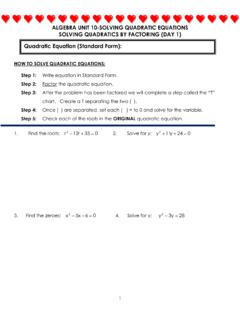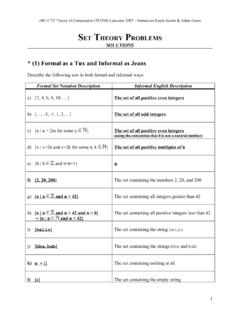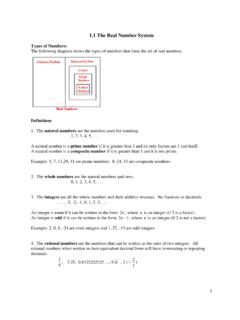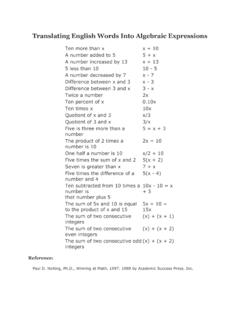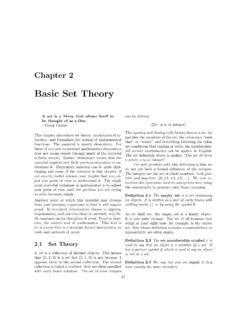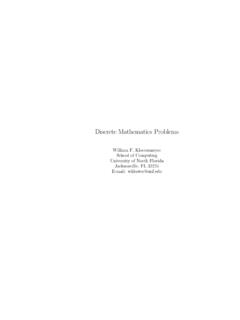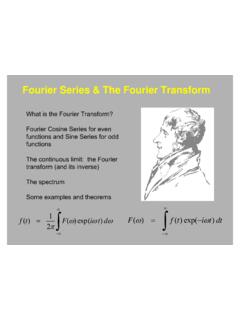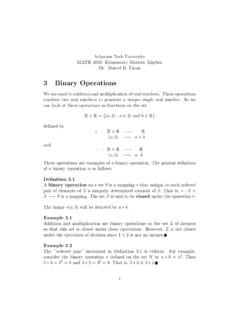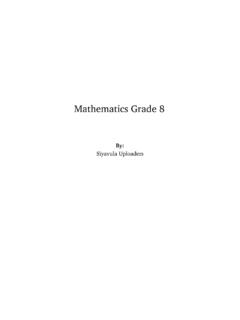Transcription of Chapter 3, Rings
1 Chapter 3, RingsDe nitions and now have several examples of algebraic systems with addition and multiplication:Z;Zn;R;Mn(R);2Z=f2njn2Zg. We will write down a system of axioms whichincludes them nition, p. a nonempty setRwith two binary operations (usuallywritten as addition and multiplication) such that for alla; b; c2R,(1)Ris closed under addition:a+b2R.(2) Addition is associative: (a+b)+c=a+(b+c).(3) Addition is commutative:a+b=b+a.(4)Rcontains an additive identity element, calledzeroand usually denoted by 0 or0R:a+0=0+a=a.
2 (5) Every element ofRhas an additive inverse: for eacha, there exists anx2 Rsuchthata+x=0=x+a. We writex= a.(6)Ris closed under multiplication:ab2R.(7) Multiplication is associative: (ab)c=a(bc).(8) Multiplication distributes over addition:a(b+c)=ab+acand (a+b)c=ac+ possible properties are captured by special types of Rings . We will encountermany in this book; many more are studied as well by inverses are thatxandyare both inverses +0 =x+(a+y)=(x+a)+y=0+y=y. We don't have to add axioms about subtraction.
3 We just de nea bto bea+( b).De ringis a ringRthat satis es the additional axiom thatab=bafor alla; areZ,R,Zn,2Z, but notMn(R)ifn with identityis a ringRthat contains a multiplicative identityelement 1R:1Ra=a=a1 Rfor : 1 in the rst three Rings above, 1001 inM2(R). The set of even integers12is a ring without identity. The set of odd integers is not a ring. We can also work withmatrices whose elements come from any ring we know about, such asMn(Zr). (Z2). This is a nite (16 elements) noncommutative ring withidentity 1R= 1001 and zero element 0R= 0000.
4 We give an example to show itis noncommutative: 1000 0100 = 0100 but 0100 1000 = 0000 Example: Rings of continuous any topological space; if you don'tknow what that is, let it beRor any interval inR. We consider the setR=C(X;R),the set of all continuous functions a ring with identity when wede ne addition and multiplication as in elementary calculus: (f+g)(x)=f(x)+g(x)and(fg)(x)=f(x)g(x). The identity element is the constant function commutativebecauseRis, but it does have zero divisors for almost all choices are many, many examples of this sort of ring.
5 The functions don't have to becontinuous. They can be restricted in many other ways, or not restricted at all. Forexample, you can look at polynomial functions or di erentiable functions (for some choicesofX).De nition, p. domainis a commutative ringRwith identity 1R6=0 Rwith no zero divisors; that is,ab=0 Rimplies thata=0 Rorb= :Z,R,Zpforpprime. Nonexamples:C(R;R),Znforncomposite, the zeroringf0Rg, the even integers nition, p. eldis an integral domain in which every nonzero elementahasa multiplicative inverse, denoteda :R,Q,C,Zpforpprime (Theorem ).
6 If an element of a ring has a multiplicative inverse, it is unique. The proof is the sameas that given above for Theorem if we replace addition by multiplication. (Note thatwe did not use the commutativity of addition.) This is also the proof from Math 311 thatinvertible matrices have unique nition, p. elementain a ringRwith identity which has an inverseu( ,au=1r=ua) new (Product Rings ).LetR; Sbe Rings and form the Cartesian productR ne operations by(r; s)+(r0;s0)=(r+r0;s+s0)(r; s)(r0;s0)=(rr0;ss0):ThenR Sis a ring.
7 IfRandSare both commutative, so isR an identity, then(1R;1S)is the identity inR the ringZ Z=f(n; m)jn; (1;0)(0;1) =(0;0) = 0R,soRis not an integral domain. For the same reason, no product ring is anintegral nition, p. subset of a ring which is itself a ring (using the same operations)is called asubring. A subset of a eld which is itself a eld is called asub a sub eld ofR, and both are sub elds a subring ofZ. Its elements are not integers, but rather are congruence classes of a subring ofZ, but the only subring ofZwith identity zero ring is a subring of every with subspaces of vector spaces, it is not hard to check that a subset is a subring asmost axioms are inherited from the a subset of a a subring ofRi the followingconditions all hold:(1)Sis closed under addition and multiplication.
8 (2) 0R2S.(3) s2 Sfor every 1, 4, 5 and 6 are in our hypotheses. Axioms 2, 3, 7 and 8 are inheritedfromR. As examples, do exercises from book, page 51{55: 7, 8, 9, 19, 34, discuss properties of { al la; b; cin a ringR,(1)a+b=a+cimpliesb=c.(2)a 0=0 a=0.(3)a( b)= (ab)=( a)b.(4) ( a)=a.(5) (a+b)=( a)+( b).(6) ( a)( b)=ab.(7) ( 1)a= aifRhas an identity make use of the de nition of subtraction and negatives. For (1), add a.(2)a 0=a(0 + 0) =a 0+a 0anduse(1).(3) Show thata( b)and( a)bare additive inverses forab(we know there is a uniquesuch element).}}
9 (4) and (5) De nition of additive inverse.(6) Use (3) and (4).(7) Use (3) or add ( 1)atoa. A quicker version of Theorem can be obtained using a ring and;6=S a subring ofRifSis closed undersubtraction and need to showSis closed under addition, has 0 and has additive inverses. ButS6=;implies there is somes2S, hence 0 =s s2S. For anya2S, a=0 nally, fora; b2S,a+b=a ( b)2S. Notation:Forain a ringRandn2Z, writenafor a sum ofncopies ofaandanfor a product ofncopies ofa. This includes the cases 0 a=0 Randa0=1 RifRhas anidentity careful: (a+b)2=a2+ab+ba+b2cannot be simpli ed unless the ring is a ring anda; b2R.
10 The equationa+x=bhas the uniquesolutionx=b ais a solution: check it! Ifzis another solution, thena+z=b=a+(b a),soz=b aby cancellation (Theorem ). For multiplication, we need multiplicative inverses to get the cancellation in the a ring with identity anda; a unit, then the equationsax=bandya=bhave unique solutions 1bandy=ba 1are solutions: check! Uniqueness works as in Theorem ,using the inverse for cancellation: ifzis another solution toax=b,thenaz=b=a(a 1b).Multiply on the left bya 1to getz=a 1az=a 1a(a 1b)=a 1b.





![Tabl e: Cumulative Binomial probabilities [ ] n ( ) P X c ...](/cache/preview/3/0/e/d/f/4/3/1/thumb-30edf4310c295959b164370ee641e1ff.jpg)

